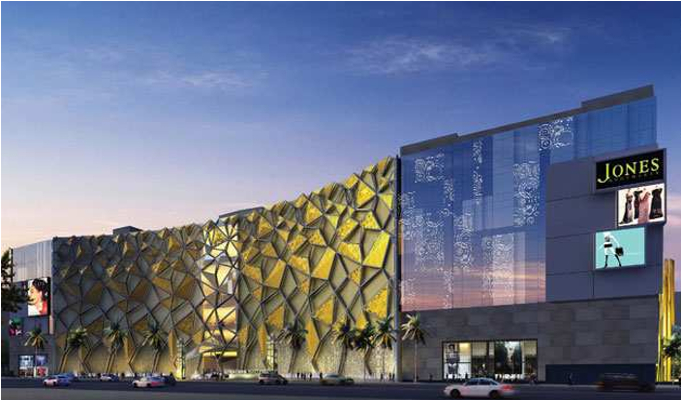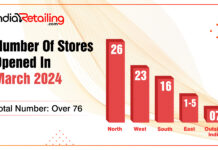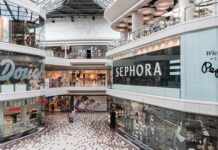Retail is rising in the East. What was unthinkable up until a decade ago has now become a reality. Today, customers belonging to a diverse milieu are making a beeline for malls – to look, touch, feel, buy, and revel in the experience of a community hub. The availability of high-end national and international products is making the lure of the mall all the more irresistible for the Eastern populace.
The desire for shopping is not restricted only to the high and the elite group but has now finally trickled down to the aspiring middle class. The organised sector’s growth potential has increased due to changing lifestyles of consumers, high consumer spending capacity of the young population, and sharp rise in disposable incomes. Apart from metro cities there is a radical shift witnessed in consumption pattern in smaller towns with people moving beyond necessities and buying products tagged as lifestyle luxury item. The demand is shooting up as foreign brands are betting on India’s US $600-billion retail market.
The Indian consumer market has seen a significant growth post-recession era and as a result, the entire country – including the East – is witnessing huge number of shopping malls and complexes coming up. The investors and developers are lining up, and a huge amount of foreign capital is flowing into the region, giving offline retailers a reason to come up with new stores and implement new technology.
And malls are increasingly turning to the social media to step up their game. Although traditionalists may think the Internet is the worst enemy of the mall – a brick-and-mortar bastion – this could not be farther than the truth. Malls are taking the best of both worlds – offline and online – and blending them into a winning proposition to enhance the consumer’s shopping experience.
Malls are using social media to engage visitors when they are not in the mall – offers, promotions, contests, polls, customized offers, gift ideas, targeted advertisements based on real time intelligence and location-based marketing and of course information, everything is available to consumers, drawing them to the mall, making them want to visit again. Malls are also increasingly turning Omnichannel, making use of the consumer’s smartphone to attract him/ her in. In short, smart malls of the East are using digital technology to heighten their unique value propositions.
Despite the upswing in the mall scenario in the East, a lot still needs to be done to ensure that shopping centres prosper in the region. Good government policies, more innovation in terms of incorporating value-added elements, melding retail and entertainment in one giant community hub, and using the digital media to attract footfalls – all need to be worked upon.
More planning, better identification of needs, quality products at affordable prices, a perfect store mix – all these factors still need refinement to ensure the success of malls and the shopping centre industry in East India.
IMAGES Retail Bureau spoke to major mall developers from the East to find out how the retail landscape of the region is changing, why the growing influence of digital media in retail is not all bad news for malls and how they are transforming the consumer’s experience by leveraging technology and multichannel strategies.
1How are malls changing the retail landscape of the East?
Sanjeev Mehra, Vice President, Quest Properties India Ltd.: Malls, as we understand, are the culmination of food, non-food and retail combined with entertainment. Kolkata being one of the oldest cities of the country saw the British make one of the iconic markets known as Sir Stuart Hogg Market – more popularly called New Market – which a mirror image of the Covent Garden Market in London with its cobblestone walkways. Malls are not new to India, especially in the East, as under one roof you are able to get food, non-food, retail and entertainment.
The growth of cities in the east into suburbs has increased the demand that retail needs to be available at the consumer’s doorstep.
Malls are a must for any developing city and have now become centers for leisure, entertainment and community building. The Eastern part of the country is showing confidence by building malls in Guwahati, Siliguri, Ranchi, Dhanbad, Patna and Kolkata. The dynamics of retail especially in the original market, the brands and the aspiration of the youth drive this generation to create these centers. This is showing very healthy consumption patterns and the retailers are driving the developers to make centers for them. I believe we are on a very healthy course for developing further retail malls in the coming future.
Priyank Singhania, Director, Avinash Developers Pvt Ltd.: As we move into 2018, most Eastern cities of India display a glorious upward trend including Kolkata, Raipur, Ranchi, Asansol, Siliguri. Luxury buying has transmogrified from an occasional indulgence into a necessity and increasing consumer spending power is aiding this metamorphosis. The end result – the Great Indian Middle Class has been elevated to a higher level. What was unthinkable in the Eastern region a few years ago is becoming a reality, and the credit goes to premium retail destinations malls, which have opened the luxury retail gateway in the region. It is because of these premium destinations that customers belonging to a diverse milieu are making a beeline for malls to look at, touch, feel, buy and then revel in the experience of possessing high-end international and national products. East is called the retail market of tomorrow with all its potential. The factors that make these malls changing the retail landscape are better and professional mall management, the presence of international brands, and balanced floor plans.
Arijit Chatterjee, COO, Junction Mall: There is a wave of emerging aspirational brands in East India. The approach is more in the Tier I & II cities because of the change in shopping trends. There are upcoming malls in cities like Bhubaneshwar, Guwahati, Ranchi, Jamshedpur, Siliguri etc. The major finding to the trend is the middle class consumers who have been elevated to a higher level. There is a rapid transformation in eastern India market – from a traditional customer base into a fashion conscious, brand-savvy market. The young generation is shopping and demanding both fashion and quality along with value for money. To meet these expectations and demands of consumers – big and small, branded and unbranded, regional, national and even international brands are gearing up hugely, and very successfully.
Amit Tekriwal, Director, Amit Reality Private Ltd: Eastern India’s aspiration wave and changing shopping trends in the metros, Tier II and III cities of the region have driven the conventional stores to morph into more organized, large-format retail outlets. And, to facilitate this growth of retail, many retail realty projects have sprung up in all major markets of East India. Eastern states of India now display a glorious upward trend. Luxury buying has transformed from an occasional indulgence into necessity and increasing consumer spending power is aiding this metamorphosis. It’s because of such development of taste for fashion and brands customers are making a beeline for malls to look at, touch, feel, buy, and then revel in the experience of possessing highend international and national products.
Eastern India is in the cusp of being transformed from a traditional customer base into a fashion conscious, brand-savvy market. Its young generation is shopping and demanding both fashion and quality along with value for money spent from retailers. The consumers’ ambitions to reach global standards in lifestyle, coupled with high disposable incomes, are aggressively scripting a radical change in the business viability of organised retailing East India.
Shantanu Lahiri, Chief Advisor, JD Hi Street: Though little late in the day, the populace of Eastern India has learnt to adapt themselves to the changing purchasing pattern. The retail, wholesale and the distribution industries are undergoing a period of transformation with broader retail market at a growth of 5-6 percent annually. Therefore, brands are searching for ways to increase their market share and hence profitability. Eastern India is no different to the change. One umbrella solution and experience has always been the key differentiator expected by an ever-changing market palate. Though disruption is the new normal, but retailers will always harp on spaces to offer their product experiences to the prospective consumer, irrespective of the brand. Malls have had their contribution to the economic growth, educative purchasing behavior clubbed with entertainment under one umbrella.
Although there were malls present in the metro cities of Eastern India a little over a decade now, however, Ranchi, Jharkhand’s capital, witnessed its first mall in the form of JD Hi Street, which is located right on the city’s main road. The entire stretch of the main road is like a pronounced paradise for all kinds of shoppers. JD Hi Street had gauged this changing trend almost seven years ago and decided to come up with the solution for Ranchi-ites as well as tourists in the shape of a mall. JD Hi Street has had the first mover’s advantage and were instrumental in bringing in a mall culture to Ranchi. As a result, we have been able to rope in top brands including our anchor store Reliance, Carnival Cinemas, gaming zone amoeba and state-of-the-art culinary offerings on our fourth floor. We have been awarded many times for our experiential offerings especially since we have addressed the four catalysts: the economy through affordable prices and brands, enabling technologies within the set-up like Wi-Fi enabled Mall, platforms for entertainment across the mall, events for consumer engagement and entertainment. The goal of JD Hi Street is to have maximum engagement and consumers within the mall to enjoy a great experience and ambiance
Bishnu Kumar Agarwal, Chairman and Managing Director, Adarsh Heights Private Ltd.: Eastern India is in the cusp of being transformed from a traditional customer base into a fashion conscious, brand-savvy market. It’s the younger generation that is shopping and demanding both fashion and quality along with value for money spent from the retailers. To meet these impossible demands retailers – big and small, branded and unbranded, regional, national and even international – are gearing up huge and very successfully. To cater to these consumers, retailers need to wake up to the importance of managing retailing efficiently and effectively. Retail management saves time and ensures the customers easily locate their desired merchandise at the more organised platform and return home feeling satisfied that they have received what they have paid for. The consumers’ ambitions to reach global standards in lifestyle, coupled with high disposable incomes, are aggressively scripting a radical change in the business viability of organised retailing East India.
Sahil Saharia, CEO, Bengal Shristi Infrastructure Development Ltd.: The consumers’ ambitions to reach global standards in lifestyle, coupled with high disposable incomes, are aggressively bringing about a change in organised retailing in East India. Luxury buying has increased manifold due to increased consumer spending power. What was unthinkable in the Eastern region till a few years ago is becoming a reality now, and the credit goes to premium retail like Quest which has brought brands like Breitling, Canali, Michael Kors, Burberry, Emporio Armani, Paul Smith, Super Dry, Hugo Boss and many more into the region. South City Mall took a very bold step closing down the mall for a year, in spite of being one of the most successful malls in India. They did so to take it up to the next level in terms of look and experience and also for creating spaces for brands like Zara, Forever 21, Sephora, Starbucks as well as a lot of other international brands which are totally new to Kolkata and Eastern India.
Along with this, brands like H&M, and Hard Rock Café – which recently opened on the high streets – have already started to bring about a significant change in the retail scenario in the East. Other cities in the region like Bhubaneshwar, Ranchi and Patna are also changing in terms of creating more organised retail space in the form of malls to accommodate the rising demand.
In smaller cities like Asansol and Durgapur, the malls are seeing better footfalls and conversions than earlier since the local population is also aspiring to reach better standards of fashion and lifestyle due to increased disposable income. This is also leading to the strong local retailers taking up mall spaces to address the shift of customers from congested traditional marketplaces to malls.
East has been a little slow in the mall development area but with advent of good malls in Tier II cities of the region is giving a good competition to the other regions across India. We are growing steadily and are on the right track to develop more retail malls in the future.
2Tell us in detail about your social media marketing/digital strategy. What are you doing that’s setting you apart from other malls?
Sanjeev Mehra: I think it’s become apparent that malls have cyber avatars and people want to be in a mall even if they are not physically present to know what is being offered by having an update about the information. The fast word of social media drives to have strategies and hourly updates to know what is happening in the mall. Our cyber patrons are now getting regular information and live updates about where one would get exclusive previews of things happening in the mall. You must also understand that this is a double-edged sword and sensibility and sympathy must be pillars when engaging our patrons.
Priyank Singhania: Magneto Mall always believes in offering better services to consumers and give them memorable experiences that they share with their loved ones. Hence, it’s very important to stay connected with them and keep them updated with every single activity happening at the mall. We have leveraged digital with new features on our website www.magnetothemall.in and on our mobile app. This feature helps our retailers stay connected with consumers. Our website is interactive, user-friendly, filled with every possible information that would be beneficial for consumer needs. We are also very active on social media platforms, making sure that we draw in huge traffic and engage consumer’s online real time. To ensure more consumer loyalty, we have introduced a Magneto Privilege Card.
The Magneto Mall Facebook page is engaging and useful for our patrons and posting brands offers, events details to stay connected with our customers. Digital video walls and LEDs across Magneto for adverting are used in conjunction with BTL promotions and act as the perfect platform to launch and promote retail offerings digitally, along with on-ground activities.
Arijit Chatterjee: Digital marketing has become a very important element for any marketing strategy in current phase. We have a dedicated marketing team working on different strategy. The continuous process includes Eye-catching content writing, posting regular updates such as retailers offers/information’s on Twitter, creating mall events, guest engagement posts etc. We have also started doing interactive posts on Facebook, running contests on various occasions.
Amit Tekriwal: The detailed Social media marketing/digital strategy which we do every month is as follows:
1) FB Engagements via information, offer, ads, event ads etc
2) FB Creative and Video
3) SMS Marketing
4) E-Mail Marketing
5) FB Lead Generation
6) Contest to win vouchers in eateries, Cinemas etc.
7) Bokaro Mall Website Maintenance, Surveys & Space Branding Page
Due to our social media campaign we have established the following things which set us apart from others. Brand awareness has increased among the consumers. Even the number of footfalls has also increased in the mall. Our search engine rankings has improved. With increased visibility, there is a step growth in the Mall retailers business gains and there is more opportunities for conversion. Every blog post, image, video, or comment may lead viewers to your company’s website and increase traffic and learn about the latest offers and promotion of the retailers.One of the main goals of almost all businesses is developing a loyal customer base. Considering that customer satisfaction and brand loyalty typically go hand in hand, it is important to regularly engage with consumers and begin developing a bond with them. Cost-Effective Social media marketing is possibly the most cost-efficient part of an advertising strategy. Signing up and creating a profile is free for almost all social networking platforms, and any paid promotions we decide to invest in are a relatively low cost compared to other marketing tactics.
Shantanu Lahiri: Social Media is hygiene for any organization in the day. JD Hi Street has always been very active on social media for the purpose of dissemination of information and most importantly branding. The mall is a destination by itself and the default advantage is attained by the in-house brands. The digital interfaces are its e-communications, its website, Facebook interaction sessions and contests, professional engagement through LinkedIn, and SMS promotional offers. We have a unique set-up that seamlessly interfaces and connects the consumers with the Brands available in the mall. The various events at the mall create an environment of engagement which are branded through Social Media engagement programmes. The strategy for social media is kept simple with full focus on the engagement and hence higher reach.
Bishnu Kumar Agarwal: Traditional advertising doesn’t give you the luxury to reach out to your target audience the way social media ads do. It simply doesn’t work that way. When you’re doing offline advertising, you’re taking the blind, shotgun approach where your returns are dismal even if you’re making big investments. Using social media ads, you reach out to targeted prospects, increase your conversions and ultimately get a higher return on investment. As a mall developer, we are quite aggressive through our Social Media marketing. We encourage, monitor, reviews, promote sales at retail stores, and promote events in a better way.
Sahil Saharia: Our website is user-friendly, interactive, and filled with every possible information that a consumer would need. We are also very active on social media platforms, making sure that we draw in huge traffic and engage consumers’ online real time.
We are leveraging Digital and Social Media channels to connect with shoppers and bring them to the stores in our malls. We run campaigns that inform shoppers about new store openings, special seasonal offers and events happening at the mall. We also encourage our audience to post on our official social media platforms, while they are having a good time at the mall as part of our social media engagement.
Sunil Agarwal: P&M Mall is very much active on social media. We update the details of all our events, both upcoming and past, on our social media page. We also address customer satisfaction or dissatisfaction over social media and I think this the best platform to be connected with our customers.
3How are you integrating digital and social media to the overall mall experience? What kind of technologies have you adopted for the consumer’s convenience?
Sanjeev Mehra: We are in song with all the social media platforms from Facebook, Twitter, Instagram, etc. We have one of the largest followings on social media and we are now working with new agencies which would provide us an app to generate cyber events for our mall. We believe that the social media and the marketing must engage our patrons to enjoy the mall experience. It must not deter our patrons from coming to the mall.
Priyank Singhania: Magneto Mall has introduced digital media as a platform to launch and promote brands at the mall. Our website is interactive and user-friendly. We are also very active on social media platforms, making sure that we draw in huge traffic and engage consumer’s online real-time by posting regular offers, stores opening, fresh season collection, weekend activities, new movies release and many more activities related to mall. Apart from this, we offer personalized services ranging from booking a cab, restaurant reservation to bill payments which are promoting regularly.
Arijit Chatterjee: Social media being the most booming platform to cultivate exposer and opportunities in the market for any organization now days, we uplift and share all the activities organized by Junction to the World via periodic interactive posts, live AV presence of the activities, proper activity and event calendar execution on Facebook. Recently we came up with a fully functional website to avail all the “Junction happenings” at Junction fan’s fingertip so that customers can sweep off Junction at a glance.
Amit Tekriwal: Primarily, our Campaign rotates around FB & Bokaro Mall website. Through FB engagements we from time to time give information, offers, ads, event ads etc. Also Creatives & videos are uploaded on FB for brand & Mall Promotion. One of the most valuable advantages of social media is market insight. What better way to know the thoughts and needs of your consumers than by directly talking to them? By monitoring the activity on customer’s profiles we can see there interests and opinions that we might not otherwise be aware of if your business didn’t have a social media presence. Using social media as a complementary research tool can help gain information that will aid us in understanding customers, there needs & preferences .These tools give the ability to measure conversions based on posts on various social media platforms to find the perfect combination for generating revenue.
Shantanu Lahiri: The very idea of social media and digital marketing is that of information, emotional connect and branding. JD Hi Street uses mediums as Google, Facebook, Just Dial, LinkedIn, Trip Advisor and other reputation management tools to enable feedback mechanisms. The analysis of these digital analytics helps us to constantly change the product offerings and update the experiential component for the consumer. This keeps the customer engaged and the brands earn lot of benefit out of this endeavor.
Bishnu Kumar Agarwal: I see five stages of the retail customer journey: Awareness, consideration, purchase, loyalty and advocacy. Social media is one of the few mediums where you can authentically engage with consumers during each stage. Retailers as well as mall operators must bridge the gap between the online and offline worlds to stay profitable. And social media helps them do it seamlessly and effectively.
4How much are you investing in digital technology?
Sanjeev Mehra: I don’t think it’s possible to put an absolute number as there is so much going on. The social media marketing budget is a part of the overall marketing budget. It is dynamic, and one must be cautious as to how much one needs to invest in this sector. A percentage of the revenue generated should be the key and a benchmark to budget allocation.
Arijit Chatterjee: Around one lakh per month for digital marketing.
Amit Tekriwa: There is an investment of around 70-75k per month on digital marketing.
Shantanu Lahiri: JD Hi Street has earlier understood the need for branding through digital medium; with a mix of conventional and disruptive modes. Generally, our investment in social media is quite high and as much as 1.5 percent of its revenues are invested in digital marketing.
Bishnu Kumar Agarwal: We have not fixed our budget – this is completely based on our requirements. We revise the budget as per requirement.
Sahil Saharia: We are investing approximately Rs 25 – 30 lakh per year towards our retail projects.
5Do you do on-site digital marketing at events? Do you engage in influencer marketing? If yes, please provide details.
Sanjeev Mehra: We do on-site digital marketing events. There have been occasions that we have used digital marketing to boost our events. Platforms like Google and Facebook have been extremely beneficial for larger events at our mall.
Priyank Singhania: Yes, we do on-site digital marketing at events with promotion campaigning of brands/products through the medium of the digital wall and LED across Magneto. Along with this we post live events on Facebook to be connected with online followers. We also review all our events and promotions through our online customer feedback system. We provide this to our third party vendors, who in turn use these social media testimonials to shape the content / products they provide us with.
Arijit Chatterjee: We go Live on various occasions, especially during mall events and celebrations etc. Influencer marketing is kept in mind while designing the content for any campaign.
Shantanu Lahiri: JD Hi Street has appointed professionals to do their digital marketing. On-site digital marketing of events is done. However, the opinions of every celebrity who visits the malls are their own. We encourage reviews and ratings at various platforms to enable us understand consumers and keep upto their expectations over time.
Sahil Saharia: We are periodically organising events to increase footfalls and we encourage event attendees to share their pictures on social with the hashtag. This helps in creating a promotional boost which also creates a buzz on the social media. We also use social media groups to reach a section of like-minded customers. People, especially the Millennials, who follow various influencers across the social media platforms like Facebook, Snapchat, Instagram, etc. Even in Tier II cities like Asansol, this trend is catching up. We are revving up our social media strategy, as per the engagement and attention of the customers towards the influencers.
6Major malls across the country are going Omnichannel. Is becoming a ‘smart mall’ (going digital / Omnichannel) on the cards for you in the near future?
Sanjeev Mehra: I think Omnichannel is a necessity for the retailers and if they want to use their physical stores to sell products. I think developers who are partners on revenue shares will require a part of the action. However, the job of the mall is to create relative awareness to ensure the patrons come to the mall and spend their money, which may not have been planned. This incremental revenue is extremely important for the survival of the malls.
Priyank Singhania: Magneto Mall has become a family entertainment zone – a place where families eat, shop and indulge in leisure activities, a place where families spend quality time together. Omnichannel requires a huge investment, a well-sequenced roadmap of digital marketing and channel integration initiatives rooted in a deep understanding of customer behaviour and related economics. We are in the process of developing an Omnichannel platform to maximize on footfalls, and providing a perfect customer experience.
Arijit Chatterjee: In near future we have plans of going Omnichannel. We have plans of setting up of interactive mediums of e-portals in mall. This will provide both online and offline shopping experience to customers in mall.
Amit Tekriwal: Yes we are evaluating and keeping a close watch on the bigger players to follow them suitably.
Shantanu Lahiri: JD Hi Street is a brick-and-mortar mall. Though disruption across the country and in Eastern India has happened, however, for purpose of purchases of materials of fashion, lifestyle, daily needs, apparels have a long way to go in India. Honestly, we feel that there is a trust gap between the consumers and manufacturers/retailers and that is one of the reasons, Omnichannel may not work for the market. There may be occasional spikes in the varied product purchases but there is still time for consumers to get thoroughly into smart-phone shopping, online shopping. Till then, JD Hi Street will practice in giving the best on-site experiences to the consumers, entertain them and offer the best brands to the people of Ranchi. To be specific, Omnichannel expansion of JD Hi Street is currently on the cards.
Bishnu Kumar Agarwal: For smaller centres, in secondary and tertiary retail locations, there is ample opportunity to level the playing field. As social media has very low costs as such, an effective idea need not be an expensive one, just one worth sharing. Lot of businesses in many categories, and shopping centres are still in the experiential stage. They are discovering that social media is not like any other medium at their disposal. There is not a silver bullet of measurement for an activity that crosses advertising, PR, market research, community relations and customer service is not a reason to turn away from social media. It is more of an opportunity to figure out that ‘if social media is growing at a furious rate, what do we need to do to be more relevant to the customers who are using it?’
Sahil Saharia: The future of retail is Omnichannel. This modern trend towards an Omnichannel strategy will enable retailers to re-think their business strategy in order to tap the best of both worlds and maximise on footfalls. Omnichannelisation is definitely on the cards as this is essential in order to stay relevant to our customers.
Sunil Agarwal: Our approach to Omnichannel is very flexible. We will see how things progress in future and take action accordingly.








